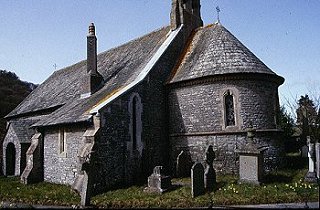

|
Back Home |

|
Index to Brecknockshire Churches survey |
Brecknockshire Churches Survey
Church of St Michael , Lower Chapel
Lower Chapel Church is in the Diocese of Swansea and Brecon, in the community of Honddu Isaf in the county of Powys. It is located at Ordnance Survey national grid reference SO0278735838.The church is recorded in the CPAT Historic Environment Record as number 16385 and this number should be quoted in all correspondence.

Summary
Small church dedicated to St Michael and also known as Llanfihangel Fechan, set in sub-rectangular churchyard on the east bank of the Honddu, 7km north of Brecon. It was apparently established at the end of the 18thC, and consequently contains nothing of earlier date.
The extent of 1863 rebuilding is not documented, but fabric differences between nave and chancel might indicate two builds; possibly the nave, with later fenestration, is the original, late 18thC structure.
Parts of the following description are quoted from the 1979 publication The Buildings of Wales: Powys by Richard Haslam
History
Founded c.1790 with no evidence of an earlier structure on the site, the church is dedicated to St Michael, hence its alternative name of Llanfihangel Fechan. Rebuilt in 1863-4 by Thomas Nicholson, and the sanctuary 'beautified' in 1880.
Architecture
Church consists of nave with east bellcote, south porch, north vestry, south 'transept' (termed by Dawson, a side chapel), and small semicircular sanctuary. It is aligned south-west/north-east, but 'ecclesiastical north' used throughout this report.
Fabrics: 'A' consists of small, occasionally medium, slabs and blocks of brown and grey sandstone, of regular appearance, though irregularly coursed and used widely throughout building. 'B' is similar but less regularity in part because masonry is less standardised.
Roofs: shale slabs throughout, with toothed, ceramic ridge tiles, and cross finials at west end of nave, chancel apex and gable end of porch
Drainage: no convincing evidence around wall perimeter.
Exterior
General. Fabric 'B' used for nave, Fabric 'A' for chancel, for vestry and probably for the porch. All dressings of yellow sandstone, including those of the buttresses which appear only against vestry and south 'transept'. Windows either of lancet type (e.g. vestry) or trefoil-headed lights (nave, south 'transept', east window of chancel).
Chancel has battered base terminating at string-course below window level; also zig-zag ornamentation below eaves. Nave shows faint batter to west end and has rough string course of projecting slabs just below eaves level on north and south.
Bellcote, containing two bells, in dressed stone at east end of nave. Brick chimney with cowl rises above wall separating nave from south 'transept'.
Porch has round-headed doorway, voussoirs of edge stones and no quoins.
Interior
Porch. Flagged floor, plastered walls, side benches in stone built into west and east walls, ceiled. Doorway has two-centred arch with broach stops to chamfers. One step up into body of church.
Nave. Flagged floor but partially covered by matting, with benches raised on wooden flooring; heating grill opposite door. Flat, ceiled roof of 24 panels divided by ribs. Splayed windows with stained glass in large south window. Two 19thC marble mural tablets on south wall.
Chancel. One step up to choir, two into chancel proper, and one more to altar. Floor tiled, some encaustic tiles. Hipped roof on converging rafters.
Vestry. Contains slate plaque of 1824/1834.
South 'transept'. Contains benches and bell-pulls. Also monument of 1796.
Churchyard
A small sub-rectangular churchyard with curvilinear east side, set on level ground and back from river terrace edge of Afon Honddu which lies about 100m to west.
Churchyard reasonably well kept and contains burials into 1980s.
Boundary: consists on south of wall, mortared in places, with concrete capping; metal railings along west side; a stone wall with coping of flat slabs on north; and on the east a higher wall in better condition, though mixture of drystone and mortared. Little variation in height between ground levels externally and internally.
Monuments: regularly laid out but not dense on south, most recent ones on west, nothing on north side. Nothing obviously pre-19thC and most belong to second half of that century. Some slabs cleared away to around northern edge of yard. Earliest recognised slab of 1827, south of chancel but in 1969 Griffiths of RCAHMW noted a stone of 1796 against the wall of the vestry.
Furniture: none.
Earthworks: internally nothing but between present perimeter and river terrace edge there is additional scarp bank and on south something rather similar, suggesting a platform pre-dating the present churchyard.
Ancillary features: on the east side are narrow, ornate double metal gates supported on stone pillars with an ornamental lamp bracket over the top. Concrete path leads from this entrance to porch.
Vegetation: two yews in west corners of churchyard, and a few small deciduous bushes elsewhere around perimeter.
Sources consulted
CPAT Field Visit: 21 November 1995
Dawson 1909, 147
Haslam 1979, 360
NMR Aberystwyth
Click here to view full project bibliography
Please note that many rural churches are closed to the public at certain times. It is advisable to check when the church will be open before visiting. Information about access, or how to contact parish clergy, can often be obtained from the relevant Diocesan Office which can be found through the Church in Wales website. Further information about Lower Chapel Church may also be found on the Swansea and Brecon Diocese website.
This HTML page has been generated from the Cadw Churches Survey database & CPAT's Regional Historic Environment Record - 17/07/2007 ( 22:01:04 ).
 The CPAT Brecknockshire Churches Survey Project was funded by Cadw as part of an all Wales survey of medieval parish churches.
The CPAT Brecknockshire Churches Survey Project was funded by Cadw as part of an all Wales survey of medieval parish churches.
Further information about this and other churches surveyed is available from the Regional Historic Environment Record, Clwyd Powys Archaeological Trust, Curatorial Section, 7a Church Street, Welshpool, Powys, SY21 7DL tel - (01938) 553670, fax - (01938) 552179, email - chrismartin@cpat.org.uk, website - www.cpat.org.uk.